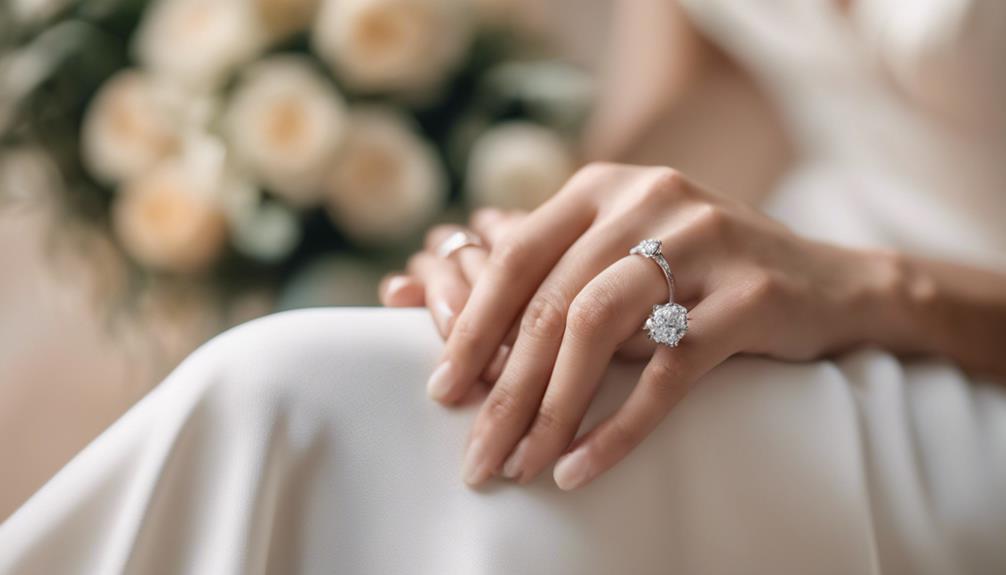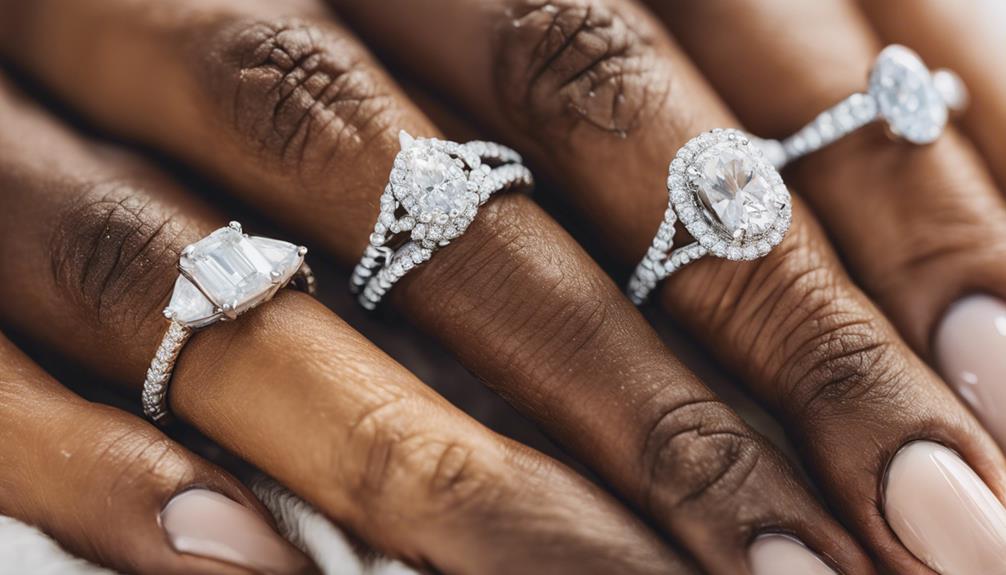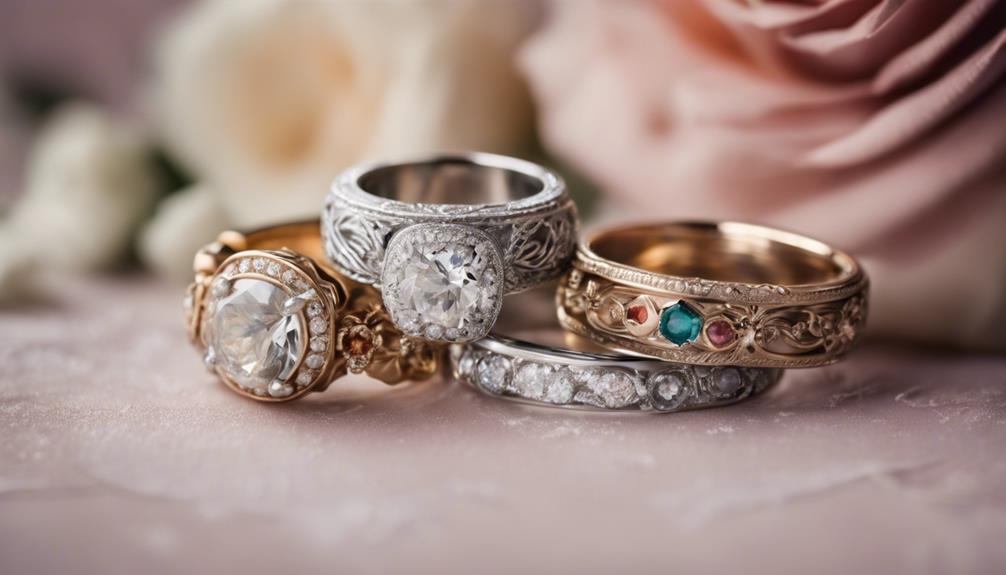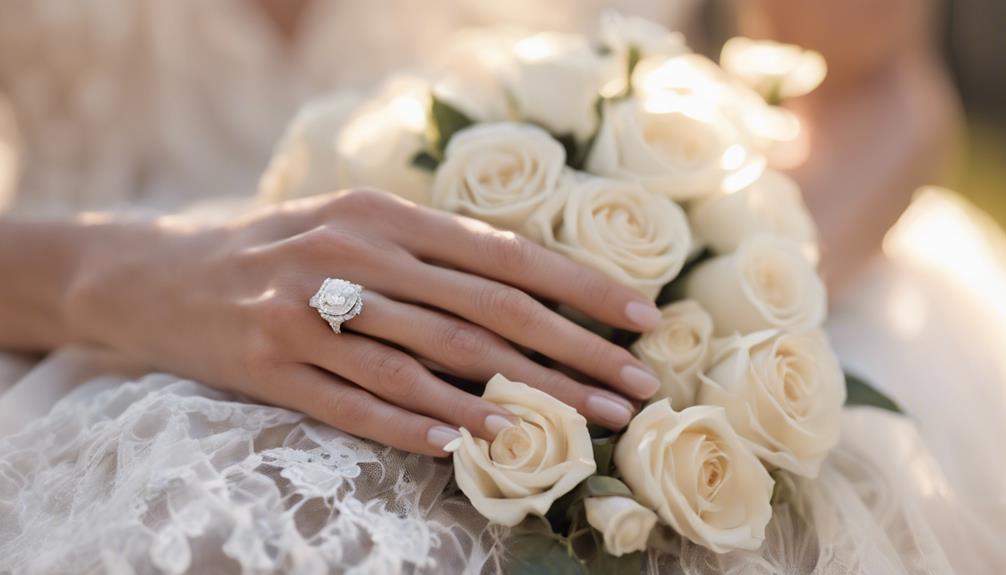You can wear your wedding and engagement rings in a way that’s meaningful to you. Traditionally, the wedding band goes on first on the left ring finger, closest to the heart, with the engagement ring stacked on top. During the ceremony, you might temporarily shift the engagement ring to your right hand. Some prefer to wear rings on a necklace or a different finger, exploring alternative expressions. Cultural differences exist, such as the right hand preference in India or Germany. Don’t hesitate to stack, engrave, or mix styles to showcase your unique story and values. There’s so much more to discover.
Traditional Ring Placement

In traditional ring placement, the wedding band typically sits closest to the heart, symbolizing the primary commitment. This practice involves placing the wedding band first on the left-hand ring finger, followed by the engagement ring on top. This arrangement is common in many Western cultures, reflecting a chronological order of promises made and commitments fulfilled.
You might find that during your wedding ceremony, it’s customary to temporarily move your engagement ring to your right hand. This allows the wedding band to be placed on the left hand first, maintaining its symbolic closeness to the heart. Once the ceremony concludes, you can reposition your engagement ring on top of the wedding band, completing the traditional look.
However, personal preference plays a significant role in how you choose to wear your rings. While the traditional practice is widely embraced, some couples opt for unique arrangements that best reflect their personal style or comfort.
Whether you decide to follow custom or forge your own path, the placement of your rings should ultimately resonate with your unique love story. Your choice in how to stack or wear your rings is a personal expression of the commitment they represent.
Creative Ring Styling
Exploring creative ring styling opens up a world of possibilities for showcasing your personal taste and individuality. You don’t have to limit yourself to traditional placements of your engagement ring and wedding band. Instead, embrace your personal style by experimenting with different arrangements.
Perhaps you wear your engagement ring on a different finger or even a separate hand from your wedding band, creating a unique look that’s all your own.
Stacking rings is another trendy option, allowing you to layer multiple wedding bands or add promise rings to your collection. This approach not only highlights your personal milestones but also offers creative freedom to switch up your look whenever you desire.
You might even choose to alternate rings based on the occasion or outfit, opting for a sparkly engagement ring for formal events and a simpler band for everyday wear.
Consider these creative styling ideas:
- Experiment with ring placement for unique combinations.
- Layer stacking rings to showcase personal milestones.
- Alternate rings for different occasions and outfits.
- Engrave custom messages on your wedding band for added personalization.
- Wear rings as necklaces or bracelets for a versatile look.
With these options, your rings can truly reflect your unique journey.
Hand and Finger Choices

While experimenting with ring styles and arrangements, it’s equally important to contemplate which hand and finger will best suit your personal and cultural preferences.
In many Western cultures, the left ring finger is the traditional choice for both your engagement ring and wedding band. This practice is rooted in the belief that a vein, the “vena amoris,” connects this finger directly to the heart, symbolizing love and commitment.
However, cultural norms vary considerably across the globe. In some Eastern European, SWANA, and Latin American cultures, wearing the wedding band on the right hand is customary. This practice showcases regional traditions and personal significance.
In countries like India and Germany, the right hand is also favored for wedding rings, reflecting rich cultural diversity.
Swiss customs provide yet another variation, where the engagement ring is worn on the right hand, while the wedding band resides on the left.
Meanwhile, some LGBTQ+ couples choose the right hand for their rings as a statement against traditional conventions, prioritizing personal expression.
Ultimately, selecting the hand and finger for your rings is a deeply personal decision.
Whether you follow cultural norms or forge your own path, let your rings reflect your unique love story.
Ring Order Preferences
Choosing the order in which to wear your wedding and engagement rings can reflect both tradition and personal preference. Traditionally, you wear the wedding band on the left hand, closest to the heart, with the engagement ring placed above it. This ring order symbolizes the journey from engagement to marriage.
Before the ceremony, you might move your engagement ring to the right hand, allowing the wedding band to take its place on the left during vows. Afterward, you can return the engagement ring to its spot above the wedding band, signifying the union.
However, you have the freedom to deviate from tradition based on personal comfort or significance. Some people prefer wearing rings on separate fingers or even different hands. Cultural customs also play a role, as some regions favor wearing the wedding band on the right hand.
Consider these common ring order preferences:
- Wedding band closest to the heart on the left hand
- Engagement ring on the left hand, above the wedding band
- Switching the engagement ring to the right hand temporarily
- Wearing rings on separate fingers for comfort
- Cultural customs dictating right or left hand preference
Ultimately, choose what best represents your love story.
Personalizing Your Rings

Personalizing your rings transforms them from mere jewelry into a unique declaration of your relationship. Adding custom engravings, like initials or special dates, enhances your engagement and wedding rings with sentimental value. These details make your rings a distinct representation of your bond, offering a constant reminder of shared experiences and milestones.
Consider incorporating colored gemstones to express your individuality. Mixing traditional diamonds with stones of personal significance not only adds a splash of color but also creates a one-of-a-kind aesthetic. Custom-designed rings reflect your personal stories, turning them into a meaningful representation of your journey together. This level of personalization guarantees your rings are as unique as the love you share.
You might also opt to stack multiple bands, such as including promise rings or other symbolic pieces. This approach allows you to create a layered look that signifies various stages in your relationship.
Additionally, choosing alternative materials, like lab-grown diamonds or ethically sourced gemstones, aligns your rings with values of sustainability and individuality. Ultimately, personalizing your engagement and wedding rings guarantees they’re not just symbols of commitment but tangible expressions of your unique love story.
Conclusion
Ultimately, how you wear your wedding and engagement rings is all about personal preference and the story you want to tell. Embrace tradition if it resonates with you, or get creative with styling and hand choices. Whether you stack them in a particular order or switch fingers, it’s your unique journey and love story that matter most. Let your rings be a reflection of your personal style and the cherished memories they symbolize.



